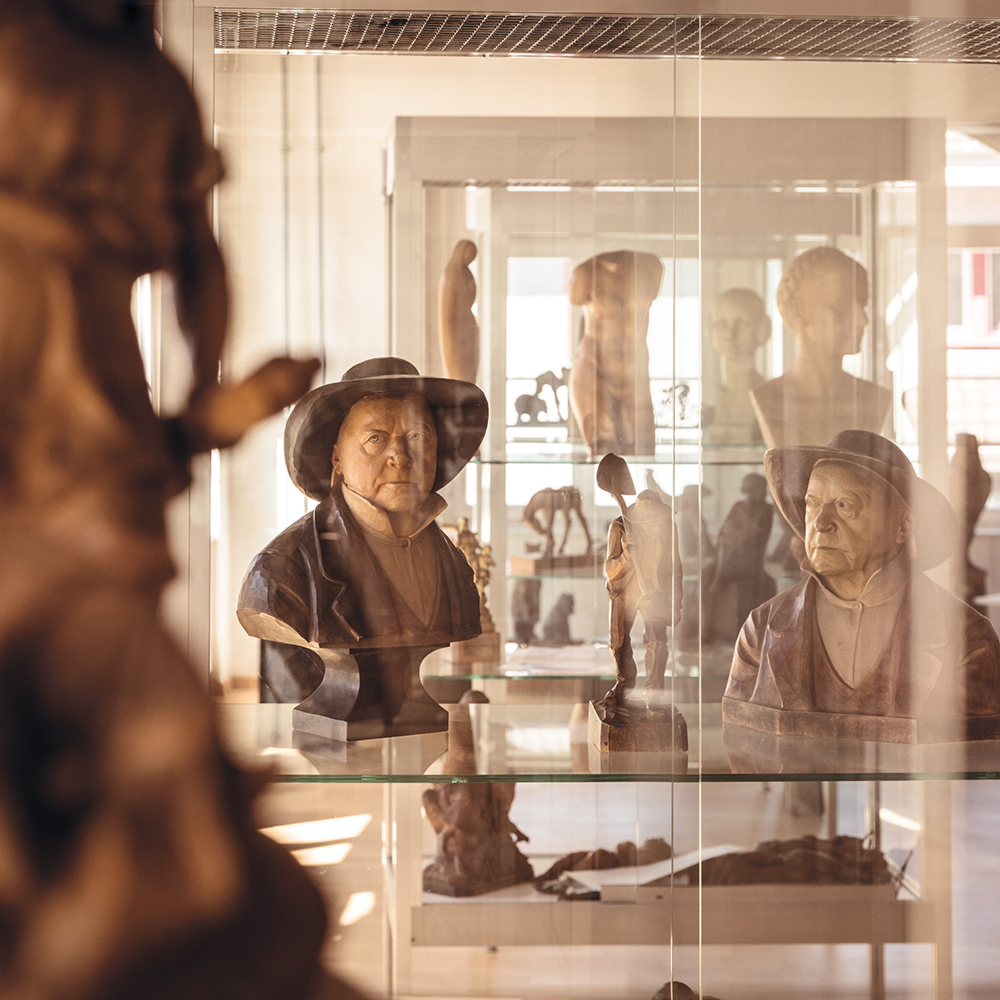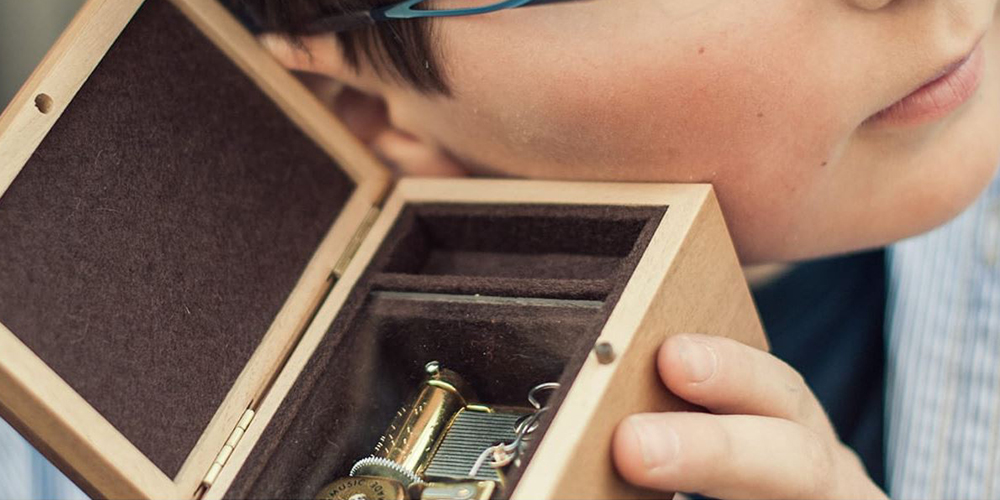

In the hunger years of 1816/17, i.e., at the beginning of the 19th century, Christian Fischer from Brienz began to decorate everyday objects and utensils with carvings and sell them to tourists. Within just one generation, the trade in gift and souvenir articles developed into a flourishing branch of the economy. It provided an urgently needed additional or even main source of income for many families. Carving was done in one’s own workshop (“Bbudiigg”), in home work or increasingly also in salaried employment. Trading companies with subsidiaries were responsible for sales all over the world.
From 1850 onwards, in addition to the ornamental production of consumer goods, more and more sophisticated wooden sculptures with human, animal and plant motifs were produced. In the first boom period, the principal masters created award-winning works of art. Their demanding clientele also included the young federal state of Switzerland with its buildings of the Federal Parliament and the City Hall in Bern.

«Bbudiigg» means workshop

From the beginning, wood carving in Brienz and the Bernese Oberland was strongly dependent on economic developments and fashionable trends. Accordingly, it experienced periods of prosperity and crises. The economic slump at the beginning of the 20th century, combined with the “new objectivity in building and living” meant that woodcarvers could hardly find a market or employment. After 1974, a renaissance of the wood carving profession began. The love of nature brought more and more young people to this craft. Although there are no longer many full-time woodcarvers, the “Woodcarving School” is very popular. It is attended by students from all over Switzerland.
Woodcarving now also has a high tourist value, and the Brienz region, as a “carving village”, attracts tourists from all over the world to the eastern Bernese Oberland. The authenticity of the old tradition, the closeness to the natural material and nature, and the highly skilled creativity of the artists inspire visitors from all continents. With its strong charisma, Brienz is part of the Interlaken holiday region. … and unique mementos of a beautiful trip to Switzerland are also guaranteed.

The Most Important Woodworking Companies in Brienz
Artistic admiration often and readily focuses on the individual carvers. Nevertheless, it was usually the companies that set the tone in many respects. The companies, with their business acumen, financial resources, marketing efforts, presentation, export and more, made it possible for the individual carver to earn an income in the first place. The other side of the coin was that the carvers were often financially at the mercy of the companies. Most carvers were actually part-time craftsmen and had a small farm on the side.
Most of the company founders were people who had moved to the area. “Love-hate” was probably the best description of the relationship between the firms and the carvers for a long time. However, the companies also had a positive influence in terms of quality and also brought about new product lines and took part in large exhibitions.
Today, Brienz is the undisputed ” carving village ” of Switzerland. It is the heart of wood carving, and the following companies provide a wide range of products and valued jobs:

Today, Brienz is the undisputed ” carving village ” of Switzerland.

Ed. Binder – Ed. Jobin Inc.
Today’s Ed. Jobin Inc. was founded in 1835 under the name of J.M. Roetter, Stuffer & Cie. None of the three founders was from the Oberland and none was a carver. J.M. Roetter came from Baden-Baden, Germany, Sebastian Binder from Uders, Tyrol, Austria, and Christian Stuffer from the Val Gardena in Italy. The company in Brienz served as a supplier for Roetter’s business in Baden-Baden, one of the fashionable and elegant health resorts of the rich and powerful Europeans at that time. The death of Mr. Roetter in 1860 split the company: Ed. Binder, the son of Sebastian took over the Brienz business and Christian Stuffer the one in Baden-Baden. In 1887 Eduard Binder jr. inherited the company and two years later the name was Ed. Binder & Cie. In 1926, the son Eduard took over. Under his name, the company was most successful in artistic and economic matters. After the bankruptcy of the Wirth brothers around 1883, the Binder company was a leader in the industry with about 200 employees, about half of whom worked part-time. Numerous other carvers were so-called “freelancers”. Exports were an important pillar of the Jobin AG company. There were permanent branches in Lourdes and Lyon in France as well as in Hamburg in Germany. Their broad wooden goods production was the largest in the industry.
The Second World War and Eduard Jobin’s tuberculosis illness brought the company into financial difficulties. Eduard Jr. took over the company and tried to get by with bank loans. He sold carvings in US army canteens in Germany and expanded his range with music boxes as well as souvenir and gift items. With antique pieces, he opened a small new shop and a museum. Today, the company is family-owned with Flavius Jobin in the fifth generation after Sebastian Binder.

Huggler-Wyss Inc. / Huggler Woodcarving Inc.
The company Huggler-Wyss AG was founded in 1900 by Hans Huggler-Wyss, son of Johann Huggler. Hans followed in his father’s footsteps, but he also reacted to the upheaval in the decorative arts world moving towards modern aesthetics. The break with tradition did not change the production line of animals and people. The flat cut was a new technique, which did not mean abandoning the old one.
Albert Huggler became a member of his brother Hans’ company. However, he later moved to the Woodcarving School as a teacher. Albert’s son later took over the management of the company. A grandson of Albert, Willy Huggler, also worked for the company as a freelancer. The Huggler-Wyss company was known for its excellent figure carvings. Their specialities were nativity figures, 26 different ones in sizes from 12 to 63 cm.
For over 100 years, the carvers have now been carving figures that have made the craft famous all over the world. This craft and the classic style of the Huggler figures have been passed down through generations of talented sculptors and painters and are still practised with great care in the workshops in Brienz.
The original Swiss Christmas mangers, which Hans Huggler-Wyss designed in 1915, are still being carved today. The traditional costume figures are also a considerable part of today’s range. Animal figures, furred bears, eagles, Madonnas and other classical figures are also part of the range, and the assortment is constantly being expanded by creative woodcarvers, adapting to customer wishes. Whether classic or modern, the dedication to craftsmanship is reflected in all the products.

Albert Schild Inc.
4 generations – tradition and quality – also in the tourist destination of Interlaken.
In 1898, Albert Schild and his wife Martha Elisabeth opened their specialist shop for woodcarvings at Bahnhofstrasse 19 in Interlaken in the Bernese Oberland. The company produced mainly wooden toys on a small scale. For the rest of the range, they worked with the company Huggler Woodcarvings Inc. and also with various freelance carvers. In addition, there was a branch in the Hotel Palace in Montreux at that time.
At the end of 1920, his son Ernst joined the company. He expanded the product range and introduced wooden toys of his own design, which were sold throughout Switzerland. Today, the widely distributed hand-painted red wooden cow with leather ears is still known.
In 1973, his nephew Walter Andreas Fuchs and his wife Charlotte took over the company. In addition to the carvings and wooden toys, “Swiss made” souvenir articles were now added to the range. Since 1995, Kaspar Fuchs has continued to run the long-standing company in the 4th generation.
From 2006 to 2016, Albert Schild Inc. ran the museum shop at the National Museum in Zurich.

The Following Companies Have Helped to Establish the Good Reputation
Michel Abplanalp
Michel Abplanalp was one of the three most important companies around 1860, besides the Wirth Brothers and J.M. Roetter.
Ammann and Mühlemann
Ammann and Mühlemann in Bönigen was the largest company with twenty carvers.
The company’s boss was Johann Mühlemann.
Carl von Bergen
Not much is known about this company, but it was one of the few that signed its carvings, especially the very special works, which was very important for collectors. The company was represented at various exhibitions, such as Vienna 1873, Philadelphia 1876 and Zurich 1883.
Laubscher
The company Laubscher was both a producer and a retailer. Their thick catalogue from 1910 showed many boxes by Schmidiger and chalets by various manufacturers. In 1950, the company consisted only of a small shop and a short time later it was sold.
The MEHO, Meiringen Woodcarvings
The Meiringen woodcarving workshop, was known under different names from 1845 onwards: Klein und Sons, Brothers Klein as well as Klein and Knittel. Later under the name MEHO, known as a leading company in woodcarving with 40 employees. MEHO was the smaller version of the Binder company, with a wide range of products which were bought and sold by competitors.
Like Binder, MEHO won several prizes at world exhibitions such as Vienna in 1873 and Paris in 1878. The company made it through the Second World War by opening other businesses such as “do-it-yourself” carving and office equipment. In the mid-1990s, the company went bankrupt. A few years later, the building burned down completely.
Schmidiger
In the 1880’s there was a wave of new companies, including Schmidiger, which mainly made beautiful furniture. Ornaments and special furniture parts were made elsewhere, as were most other carvings. Schmidiger’s business practice was geared to the wholesale market. The company ceased to exist around 1960, after the death of the second generation.
Peter Trauffer
Peter Trauffer’s company was known as an all-rounder in the carving trade. It produced and sold the full range of carving objects in its three shops in Brienz, Lucerne and St. Moritz. One of the company’s flagship products was carved bears. The company worked mainly with freelance carvers from the Brienz region. In 1950 it was liquidated, and its inventory sold at a nominal value to Eduard Jobin’s company.
Wirth Brothers
The wooden goods factory in Seematte, an almost forgotten story of international success. It was 1843 when Eduard Wirth, an art expert from Alsace, came to Brienz….
Continue reading here
A special story … Sorry, in German only, ask us for an English version.
